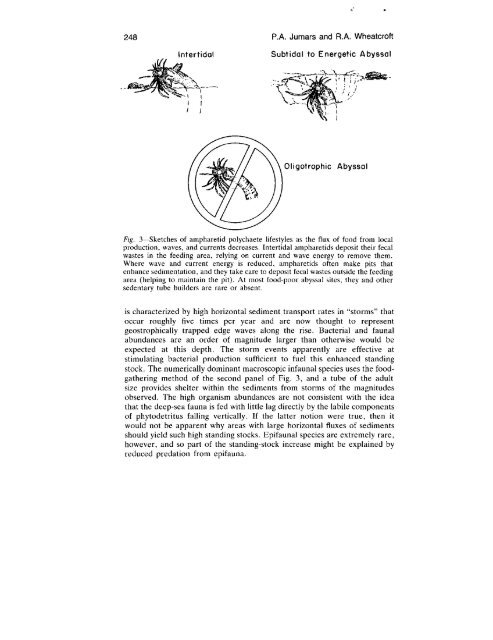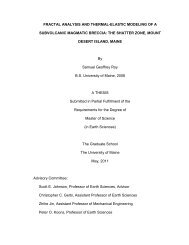Responses of Benthos to Changing Food Quality and Quantity, with ...
Responses of Benthos to Changing Food Quality and Quantity, with ...
Responses of Benthos to Changing Food Quality and Quantity, with ...
You also want an ePaper? Increase the reach of your titles
YUMPU automatically turns print PDFs into web optimized ePapers that Google loves.
248<br />
P .A . Jumars <strong>and</strong> R .A . Wheatcr<strong>of</strong>t<br />
Intertidal<br />
Subtidal <strong>to</strong> Energetic Abyssal<br />
Fig . 3-Sketches <strong>of</strong> ampharetid polychaete lifestyles as the flux <strong>of</strong> food from local<br />
production, waves, <strong>and</strong> currents decreases . Intertidal ampharetids deposit their fecal<br />
wastes in the feeding area, relying on current <strong>and</strong> wave energy <strong>to</strong> remove them .<br />
Where wave <strong>and</strong> current energy is reduced, ampharetids <strong>of</strong>ten make pits that<br />
enhance sedimentation, <strong>and</strong> they take care <strong>to</strong> deposit fecal wastes outside the feeding<br />
area (helping <strong>to</strong> maintain the pit) . At most food-poor abyssal sites, they <strong>and</strong> other<br />
sedentary tube builders are rare or absent .<br />
is characterized by high horizontal sediment transport rates in "s<strong>to</strong>rms" that<br />
occur roughly five times per year <strong>and</strong> are now thought <strong>to</strong> represent<br />
geostrophically trapped edge waves along the rise . Bacterial <strong>and</strong> faunal<br />
abundances are an order <strong>of</strong> magnitude larger than otherwise would be<br />
expected at this depth . The s<strong>to</strong>rm events apparently are effective at<br />
stimulating bacterial production sufficient <strong>to</strong> fuel this enhanced st<strong>and</strong>ing<br />
s<strong>to</strong>ck . The numerically dominant macroscopic infaunal species uses the foodgathering<br />
method <strong>of</strong> the second panel <strong>of</strong> Fig . 3, <strong>and</strong> a tube <strong>of</strong> the adult<br />
size provides shelter <strong>with</strong>in the sediments from s<strong>to</strong>rms <strong>of</strong> the magnitudes<br />
observed . The high organism abundances are not consistent <strong>with</strong> the idea<br />
that the deep-sea fauna is fed <strong>with</strong> little lag directly by the labile components<br />
<strong>of</strong> phy<strong>to</strong>detritus falling vertically . If the latter notion were true, then it<br />
would not be apparent why areas <strong>with</strong> large horizontal fluxes <strong>of</strong> sediments<br />
should yield such high st<strong>and</strong>ing s<strong>to</strong>cks . Epifaunal species are extremely rare,<br />
however, <strong>and</strong> so part <strong>of</strong> the st<strong>and</strong>ing-s<strong>to</strong>ck increase might be explained by<br />
reduced predation from epifauna .
















